|
|
 |
|
Calanoida ( Order ) |
|
|
|
Diaptomoidea ( Superfamily ) |
|
|
|
Acartiidae ( Family ) |
|
|
|
Acartia ( Genus ) |
|
|
|
Acartia ( Sub-Genus ) |
|
|
| |
Acartia (Acartia) danae Giesbrecht, 1889 (F,M) | |
| | | | | | | Syn.: | Acartia (Planktacartia) danae : Steuer, 1923 (p.35, figs.F,M); Rose, 1929 (p.48); Sewell, 1932 (p.397); Vervoort, 1965 (p.195, Rem.). | | | | Ref.: | | | Giesbrecht, 1892 (p.508, 522, 770, Descr.F, figs.F); Giesbrecht & Schmeil, 1898 (p.154); Wolfenden, 1905 (1906) (p.1023); A. Scott, 1909 (p.187, Rem.); Wolfenden, 1911 (p.357); Sewell, 1912 (p.354, 376); 1914 a (p.240); Sars, 1925 (p.362); Farran, 1929 (p.210, 282); Sewell, 1932 (p.397); Rose, 1933 a (p.276, figs.F,M); Dakin & Colefax, 1933 (p.207); Farran, 1936 a (p.122); Mori, 1937 (1964) (p.102, figs.F, Rem.F); Dakin & Colefax, 1940 (p.106, figs.F); Davis, 1949 (p.65, Rem.F,M); Carvalho, 1952 a (p.151, figs.F); Marques, 1953 (p.121, fig.F); Chiba & al., 1957 (p.310); 1957 a (p.12); Marques, 1958 (p.217); Grice, 1962 (p.240, fig.F); Brodsky, 1962 c (p.149, figs.F); Tanaka, 1965 (p.393, figs.F); Chen & Zhang, 1965 (p.113, figs.F,M); Owre & Foyo, 1967 (p.101, figs.F,M); Park, 1968 (p.569, Rem.); Ramirez, 1969 (p.85, figs.F, Rem.); Corral Estrada, 1970 (p.206); Shih & al., 1971 (p.141); Björnberg, 1972 (p.70, figs., Rem.N & juv.1 à 5); Crisafi & Crescenti, 1972 (1974) (p.232, figs.F,M, juv.); Marques, 1974 (p.18); 1976 (p.998); Dawson & Knatz, 1980 (p.8, figs.F); Marques, 1982 (p.767); Gardner & Szabo, 1982 (p.416, figs.F,M); Yoo & Hue, 1983? (p.11, figs.F,M); Rodriguez & Vives, 1984 (p.246); Sazhina, 1985 (p.79, figs.N); Yoo al., 1991 (p.258); Chihara & Murano, 1997 (p.669, Pl.17: F,M); Bradford-Grieve, 1999 (n°181, p.6, figs.F,M); Barthélémy, 1999 (p.857, 864, figs.F); 1999 a (p.9, Fig.25, A-F); Bradford-Grieve & al., 1999 (p.886, 962, figs.F,M); Bradford-Grieve, 1999 b (p.219, figs.F,M, Rem., figs.186, 195); Conway & al., 2003 (p.100, figs.F,M, Rem.); Mulyadi, 2004 (p.141, figs.F, Rem.); Vives & Shmeleva, 2007 (p.414, figs.F,M, Rem.). |  issued from : O. Tanaka in Publs Seto Mar. Biol. Lab., 1965, XII (5). [p.393, Fig.248]; As Acartia (Planktacartia) denae. Female: a, habitus (dorsal); b, last thoracic segment and urosome (left lateral side); c, last thoracic segment and genital somite (right lateral side); d, P5. Nota: In some specimens the lateral corner of the last thoracic segment has a thoracic spine divided into two on the right side.
|
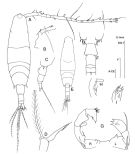 issued from : J.M. Bradford-Grieve in The Marine Fauna of New Zealand: Pelagic Calanoid Copepoda. National Institute of Water and Atmospheric Research (NIWA). NIWA Biodiversity Memoir, 111, 1999. [p.219, Fig.162]. Female: A, habitus (dorsal); B, forehead (left lateral side); C, urosome (left side); D, P5. Male: E, habitus (dorsal); F, last thoracic segment and urosome (dorsal); G, P5 (R = right leg; L = left leg); H, another view segment 1 of right P5; I, another view of exopod 2+3 of left P5. The southwest Pacific specimens show some differences from the descriptions from Giesbrecht (1892) and Steuer (1923).
|
 issued from: Q.-c Chen & S.-z. Zhang in Studia Marina Sinica, 1965, 7. [Pl.50, 7-10]. Female (from E China Sea): 7, habitus (dorsal); 8, right P5 (anterior). Male: 9, urosome (dorsal); 10, P5 (posterior).
|
 issued from : F.C. Ramirez in Contr. Inst. Biol. mar., Buenos Aires, 1969, 98. [p.80, Lam. XVI, figs.130, 132, 133]. Female (from off Mar del Plata): 130, P5; 132, forehead (lateral); 133, habitus (dorsal). Scale bars in mm: 0.4 (133); 0.1 (130); 0.05 (132)
|
 issued from : W. Giesbrecht in Fauna Flora Golf. Neapel, 1892, 19. [Taf.30, Fig.1]. Female: 1, distal part of Mxp (postruior view).
|
 issued from : W. Giesbrecht in Fauna Flora Golf. Neapel, 1892, 19. [Taf.30, Fig.23]. Female: 23, P5.
|
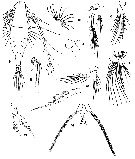 issued from : T. Mori in The pelagic Copepoda from the neighbouring waters of Japan, 1937 (2nd edit., 1964). [Pl.49, Figs.5-15]. Female: 5, A2; 6, Md; 7, Mx1; 8, 1st segment of A1; 9, habitus (dorsal); 10, Mx2; 11, Mxp; 12, P1; 13, P3; 14, P5; 15, P4.
|
 issued from : P. Crisafi & M. Crescenti in Boll. Pesca Piscic. Idrobiol., 1972 (1974), 27 (2). [p.250, Pl.XI]. Female (from off Milazzo, Sicily): f, habitus (dorsal); f ad, posterior thoracic part and urosome (dorsal);f P5, P5. Male: m ad, posterior thoracic part and urosome (dorsal); m P5, P5.
|
 issued from : R.-M. Bathélémy in J. Mar. Biol. Ass. U.K., 1999, 79. [p.863, Fig.6, A-B]. Scanning electon miccrograph. Female (from 35°30'N, 4°40'W): A, genital double-somite (ventral); note the position of the genital structures (arrows); B, detail of the right lateral genital structure; note the thin cuticular lamella (arrow) dividing the genital slit in two fields. Scale bars: 0.010 mm (A, B). Symbols: a = gonoporal field; b = copulatory field.
|
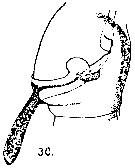 issued from : A. Steuer in Arb. zool. Inst. Innsbruck, 1923, 1 (5). [Taf. IV, Fig.30]. Female: 30, genital segment with spermatophore (lateral).
|
 issued from : A. Steuer in Arb. zool. Inst. Innsbruck, 1923, 1 (5). [p.35, Figs.167, 169]. Male: 167, last thoracic segment and urosome (dorsal); 169, P5.
|
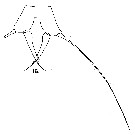 issued from : G.D. Grice in Fish. Bull. Fish and Wildl. Ser., 1962, 61. [p.238, Pl.34, Fig.16]. Female (from equatorial Pacific): 16, P5. Nota: A large spine on the 1st segment of A1. The posterior lateral margins of the thorx end in a large point. The external seta of P5 slightly more than twice the length of the internal spine.
|
 issued from : Mulyadi in Published by Res. Center Biol., Indonesia Inst. Sci. Bogor, 2004. [p.142, Fig.80]. Female (from Indonesian Seas): a, habitus (dorsal); b-c, posterior part of last thoracic segment and urosome (dorsal and lateral, respectively); d, proximal segments of A1; e, P5.
|
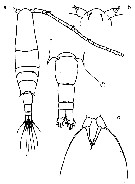 Issued from : M. Chihara & M. Murano in An Illustrated Guide to Marine Plankton in Japan, 1997. [p.675, Pl. 17, fig.2 a-d]. Female: a, habitus (dorsal); b, forehead (ventral) and proximal segment of A1; c, last thoracic segment and urosome (dorsal); d, P5. Nota: numbers show characteristics of this species to compare with A. negligens.
|
 Issued from : M. Chihara & M. Murano in An Illustrated Guide to Marine Plankton in Japan, 1997. [p.675, Pl. 17, fig.2 e-g]. Male: e, habitus (dorsal); f, last thoracic segment and urosome (dorsal); g, P5. Nota: numbers show characteristics of this species to compare with A. negligens.
|
 Issued from : J.M. Bradford-Grieve in ICES Identification Leaflets for Plankton N°181, 1999 [p.11, Figs.15 a-d]. Female: a, habitus (dorsal); b, P5. Male: c, posterior thoracic segment and urosome (dorsal); d, P5 (L = left leg; R = right leg).
|
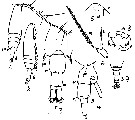 Issued from : M.C. Kos in Field guide for plankton. Zool Institute USSR Acad., Vol. I, 1972. . After Steuer, 1923, from Brodsky, 1962. Female: 1, habitus (dorsal); 21, same (lateral); 3, last thoracic segment and abdomen (dorsal); 4, same (lateral); 5, forehead (p = rostrum) (lateral); 6, P5. Male: 7, last thoracic segment and abdomen; 8, P5.
| | | | | Compl. Ref.: | | | Cleve, 1904 a (p.184); Carl, 1907 (p.17); Wilson, 1942 a (p.169); Massuti Alzamora, 1940 (p.11); 1942 (p.99, Rem.); Lysholm & al., 1945 (p.42); Oliveira, 1945 (p.191); Sewell, 1948 (p.324, 514); C.B. Wilson, 1950 (p.151); Yamazi, 1958 (p.152, Rem.); Deevey, 1960 (p.5, Table II, annual abundance), Cervigon, 1962 (p.181, tables: abundance distribution); Gaudy, 1962 (p.93, 99, Rem.: p.115) ; Grice & Hart, 1962 (p.287, table 3); Fagetti, 1962 (p.36); Ganapati & Shanthakumari, 1962 (p.9, 15); Duran, 1963 (p.25); Giron-Reguer, 1963 (p.59); Gaudy, 1963 (p.29, Rem.); Björnberg, 1963 (p.62, Rem.); Unterüberbacher, 1964 (p.31); De Decker, 1964 (p.14, 17, 29); De Decker & Mombeck, 1964 (p.11); Grice & Hulsemann, 1965 (p.225); Neto & Paiva, 1966 (p.28, Table III); Mazza, 1966 (p.73); 1967 (p.327, 367, fig.65); Pavlova, 1966 (p.44); Furuhashi, 1966 a (p.295, vertical distribution in Oyashio/Kuroshio transitional area, Table 8, 9); Cross & Small, 1967 (p.60, hydrologic indicator); Fleminger, 1967 a (tabl.1); Grice & Hulsemann, 1967 (p.20); De Decker, 1968 (p.45); Delalo, 1968 (p.138); Champalbert, 1969 a (p.612); Casanova, 1970 (p.30: Rem.); Dowidar & El-Maghraby, 1970 (p.267); Park, 1970 (p.478); Itoh, 1970 (tab.1); Timonin, 1971 (p.281, trophic group); Deevey, 1971 (p.224); Binet & al., 1972 (p.71); Subbaraju & Krishnamurphy, 1972 (p.25, 26 ); Bainbridge, 1972 (p.61, Appendix Table I: vertical distribution vs day/night, Table II: %, Table IV: seasonal abundance); Roe, 1972 (p.277, tabl.1, tabl.2); Heinrich, 1973 (p.95, fig.3); Björnberg, 1973 (p.352, 384); Corral Estrada & Pereiro Muñoz, 1974 (tab.I); Vives & al., 1975 (p.53, tab.II, IV); Peterson & Miller, 1976 (p.14, Table 1, 3, abundance vs interannual variations); Deevey & Brooks, 1977 (p.156, tab.2, Station "S"); Tranter, 1977 (p.596); Timonin & Voronina, 1977 (p.292, fig.8); Peterson & Miller, 1977 (p.717, Table 1, seasonal occurrence); Carter, 1977 (1978) (p.36); Dessier, 1979 (p.131, 201, 207); Star & Mullin, 1981 (p.1322, abundance); Sreekumaran Nair & al., 1981 (p.493), Vives, 1982 (p.295); Vaissière & Séguin, 1980 (p.23, tab.2); Kovalev & Shmeleva, 1982 (p.85, as dana); Dessier, 1983 (p.89, Tableau 1, 2, Rem., %); Scotto di Carlo & al., 1984 (104); De Decker, 1984 (p.317, 327: chart); Guangshan & Honglin, 1984 (p.118, tab.); Binet, 1984 (tab.3); 1985 (p.85, tab.3); Cummings, 1984 (p.163, Table 2); Tremblay & Anderson, 1984 (p.3); Jansa, 1985 (p.108, Tabl. III); Brinton & al., 1986 (p.228, Table 1); Brenning, 1985 a (p.28, Table 2); Madhupratap & Haridas, 1986 (p.105, tab.2); Brenning, 1987 (p.33, spatial distribution, T-S diagram, Rem.); Jimenez-Perez & Lara-Lara, 1988; Dessier, 1988 (tabl.1); Lozano Soldevilla & al., 1988 (p.60); Hernandez-Trujillo, 1989 a (tab.1); Cervantes-Duarte & Hernandez-Trujillo, 1989 (tab.3); Suarez & al., 1990 (tab.2); Madhupratap & Haridas, 1990 (p.305, fig.4: vertical distribution night/day; fig.7: cluster); Othman & al., 1990 (p.565, Rem.); Hirakawa & al., 1990 (tab.3); Yoo, 1991 (tab.1); Shih & Marhue, 1991 (tab.2, 3); Hernandez-Trujillo, 1991 (1993) (tab.I); Suarez & Gasca, 1991 (tab.2); Suarez, 1992 (App.1); Seguin & al., 1993 (p.23, 26: Rem.); Genin & al., 1994 (p.941, fig.5, patchiness); Landry & al., 1994 (p.55, abundance, grazing); Godhantaraman, 1994 (tab.6); Heinrich, 1995 (tab.1); Palomares Garcia & Vera, 1995 (tab.1); Shih & Young, 1995 (p.66); Kotani & al., 1996 (tab.2); Go & al., 1997 (tab.1, as Acarita: lapsus calami); Park & Choi, 1997 (Appendix); Suarez-Morales & Gasca, 1998 a. (p107); Noda & al., 1998 (p.55, Table 3, occurrence); Hure & Krsinic, 1998 (p.103); Padmavati & al., 1998 (p.349); Gomez-Gutiérrez & Peterson, 1999 (p.637, Table II, abundance); Dolganova & al., 1999 (p.13, tab.1); Lavaniegos & Gonzalez-Navarro, 1999 (p.239, Appx.1); Hernandez-Trujillo, 1999 (p.284, tab.1); 1999 a (p.154); Lopes & al., 1999 (p.215, tab.1); Seridji & Hafferssas, 2000 (tab.1); El-Sherif & Aboul Ezz, 2000 (p.61, Table 3: occurrence); Fernandez-Alamo & al., 2000 (p.1139, Appendix); Suarez-Morales & al., 2000 (p.751, tab.1); Haury & al., 2000 (p.69, Table 1, Fig.7); Lopez-Salgado & al., 2000 (tab.1); Belmonte & Potenza, 2001 (p.173); Lo & al., 2001 (1139, tab.I); Hernandez-Trujillo & Suarez-Morales, 2002 (p.748, tab.1); Zerouali & Melhaoui, 2002 (p.91, Tableau I); Beaugrand & al., 2002 (p.179, figs.5, 6); Peterson & al., 2002 (p.381, Table 2, interannual abundance); Mackas & Galbraith, 2002 a (p.423, Table 2); Keister & Peterson, 2003 (p.341, Table 1, 2, abundance, cluster species vs hydrological events); Lo & al, 2003 (p.89, tab.1); Peterson & Keister, 2003 (p.2499, interannual variability); Shimode & Shirayama, 2004 (p.607, tab.1, 2); Hsiao & al., 2004 (p.325, tab.1); Daly Yahia & al., 2004 (p.366, fig.4); Lan & al., 2004 (p.332, tab.1); Lo & al.*, 2004 (p.218, fig.6); Lo & al., 2004 (p.89, tab.1); Gallienne & al., 2004 (p.5, tab.3); CPR, 2004 (p.48, fig.131); Mackas & al., 2004 (p.875, Table 2); Choi & al., 2005 (p.710: Tab.III); Hopcroft & al., 2005 (p.198, table 2); Berasategui & al., 2005 (p.485, tab.1); Berasategui & al., 2006 (p.485: fig.2); Zuo & al., 2006 (p.163: tab.1); Dias & Araujo, 2006 (p.26, Rem., chart); Lopez-Ibarra & Palomares-Garcia, 2006 (p.63, Tabl. 1, seasonal abundance vs El-Niño); Ware & McQueen, 2006 (p.28, Table B1, weight ranges); Lavaniegos & Jiménez-Pérez, 2006 (p.135, tab.2, 4, Rem.); Hooff & Peterson 2006 (p.2610); Fernandez de Puelles & al., 2007 (p.338); Valdés & al., 2007 (p.104: tab.1); Dur & al., 2007 (p.197, Table IV); Zakaria & al., 2007 (p.52, Table 1, vs Salinity); Khelifi-Touhami & al., 2007 (p.327, Table 1); Jitlang & al., 2008 (p.65, Table 1); McKinnon & al., 2008 (p.843: Tab.1); Lopez Ibarra, 2008 (p.1, Table 1, 3, 4, fig.11: abundance); Humphrey, 2008 (p.83: Appendix A); Neumann-Leitao & al., 2008 (p.799: Tab.II, fig.6); Morales-Ramirez & Suarez-Morales, 2008 (p.517); Ayon & al., 2008 (p.238, Table 4: Peruvian samples); Fernandes, 2008 (p.465, Tabl.2); Selifonova & al., 2008 (p.305, Tabl. 2); Raybaud & al., 2008 (p.1765, Table A1); Tseng & al., 2008 (p.402, Table 2); Lan Y.C. & al., 2008 (p.61, Table 1, % vs stations, Table 2: indicator species); C.-Y. Lee & al., 2009 (p.151, Tab. 2, % vs hydrographic conditions); Miyashita & al., 2009 (p.815, Tabl. II); Chiba & al., 2009 (p.1846, Table 1, occurrence vs temperature change); Lan & al., 2009 (p.1, Table 2); C.E. Morales & al., 2010 (p.158, Table I); Brugnano & al., 2010 (p.312, Table 2, 3); Lidvanov & al., 2010 (p.356, Table 3); Hernandez-Trujillo & al., 2010 (p.913, Table 2); Cornils & al., 2010 (p.2076, Table 3); Schnack-Schiel & al., 2010 (p.2064, Table 2: E Atlantic subtropical/tropical) ; Hidalgo & al., 2010 (p.2089, Table 2, Fig.2); Dias & al., 2010 (p.230, Table 1); Mazzocchi & Di Capua, 2010 (p.423); Medellin-Mora & Navas S., 2010 (p.265, Tab. 2); Shanthi & Ramanibai, 2011 (p.132, Table 1); Hsiao S.H. & al., 2011 (p.475, Appendix I); Selifonova, 2011 a (p.77, Table 1, alien species in Black Sea); Tutasi & al., 2011 (p.791, Table 2, abundance distribution vs La Niña event); Andersen N.G. & al., 2011 (p.71, Fig.3: abundance); Batten & Walne, 2011 (p.1643, Table I, abundance vs temperature interannual variability); Mazzocchi & al., 2011 (p.1163, fig.6, long-term time-series 1984-2006); Kâ & Hwang, 2011 (p.155, Table 3: occurrence %); Kang J.-H., 2011 (p.219, occurrences, inter-annual variability vs t° & Sal, Chl.a., Rem.: p.228); Hsiao & al., 2011 (p.317, Table 2, indicator of seasonal change); Glushko & Lidvanov, 2012 (p.138, Tableau 1); Jose & al., 2012 (p.20, fig.3 a,b,c: % vs monsoon); Salah S. & al., 2012 (p.155, Tableau 1); DiBacco & al., 2012 (p.483, Table S1, ballast water transport); Dorgham & al., 2012 (p.473, Rem.: p.485); Jang M.-C & al., 2012 (p.37, abundance and seasonal distribution); Takahashi M. & al., 2012 (p.393, Table 2, water type index); Gubanova & al., 2013 (in press, p.4, Table 2); Palomares-Garcia & al., 2013 (p.1009, Table I, abundance vs environmental factors); in CalCOFI regional list (MDO, Nov. 2013; M. Ohman, pers. comm.); Tachibana & al., 2013 (p.545, Table 1, seasonal change 2006-2008); Jagadeesan & al., 2013 (p.27, Table 3, 4, 5, 6, fig.11, seasonal abundance); Anjusha & al., 2013 (p.40, Table 3, abundance & feeding behavior); Varadharajan & Soundarapandian, 2013 (p.2: occurrence vs stations); Hirai & al., 2013 (p.1, Table I, molecular marker); Mendoza Portillo, 2013 (p.37: Fig.7, seasonal dominance); Lidvanov & al., 2013 (p.290, Table 2, % composition); Bonecker & a., 2014 (p.445, Table II: frequency, horizontal & vertical distributions); Lopez-Ibarra & al., 2014 (p.453, fig.6, biogeographical affinity); Zaafa & al., 2014 (p.67, Table I, occurrence); Dias & al., 2015 (p.483, Table 2, abundance, biomass, production); Chiba S. & al., 2015 (p.968, Table 1: length vs. climate); Zakaria & al., 2016 (p.1, Table 1); Benedetti & al., 2016 (p.159, Table I, fig.1, functional characters); Ben Ltaief & al., 2017 (p.1, Table III, Summer relative abundance) ; Marques-Rojas & Zoppi de Roa, 2017 (p.495, Table 1); Ohtsuka & Nishida, 2017 (p.565, Table 22.1); El Arraj & al., 2017 (p.272, table 2, spatial distribution); Benedetti & al., 2018 (p.1, Fig.2: ecological functional group); Belmonte, 2018 (p.273, Table I: Italian zones); Chaouadi & Hafferssas, 2018 (p.913, Table II: occurrence); Palomares-Garcia & al., 2018 (p.178, fig.3: relative frequency, Table 1); Acha & al., 2020 (p.1, Table 3: occurrence % vs ecoregions, Table 5: indicator ecoregions). | | | | NZ: | 21 | | |
|
Distribution map of Acartia (Acartia) danae by geographical zones
|
| | | | | | | | | | | |  Chart of 1996 Chart of 1996 | |
 issued from : H.B. Owre & M. Foyo in Fauna Caribaea, 1, Crustacea, 1: Copepoda. Copepods of the Florida Current. 1967. [p.102, Table 47]. issued from : H.B. Owre & M. Foyo in Fauna Caribaea, 1, Crustacea, 1: Copepoda. Copepods of the Florida Current. 1967. [p.102, Table 47].
Vertical distribution of Acartia danae at the ''40-Mile station'' in the Florida Current (± 25°35'N, 79°27'W).
SL 53: 18 V 1958; SL 55: 21 VII 1958. A: during midday; B;: during midnight. |
 issued from : U. Brenning in Wiss. Z. Wilhelm-Pieck-Univ. Rostock - 36. Jahrgang 1987. Mat.-nat. wiss. Reihe, 2. [p.33, Fig.7]. issued from : U. Brenning in Wiss. Z. Wilhelm-Pieck-Univ. Rostock - 36. Jahrgang 1987. Mat.-nat. wiss. Reihe, 2. [p.33, Fig.7].
Spatial distribution for Acartia danae from 8° S - 26° N; 16°- 20° W, for diferent expeditions (V1: Dec. 1972- Jan. 1973; V2: Feb/Mar. 1973; VI: May 1974; IV: Jun./Jul. 1972). |
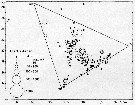 issued from : U. Brenning in Wiss. Z. Wilhelm-Pieck-Univ. Rostock - 36. Jahrgang 1987. Mat.-nat. wiss. Reihe, 2. [p.32, Fig.8]. issued from : U. Brenning in Wiss. Z. Wilhelm-Pieck-Univ. Rostock - 36. Jahrgang 1987. Mat.-nat. wiss. Reihe, 2. [p.32, Fig.8].
T-S Diagram for Acartia danae from 8° S - 26° N; 16°- 20° W.
SO: Southern Surface Water (S °/oo: 34,50; T°C: 29,0); ND: Northern Water of the Surface Layer (S °/oo: 37,5; T°C: 21,0); SD: Southern Deep Water of the surface layer (S °/oo: 35,33; T°C: 13,4). See commentary in Temora stylifera and Brenning (1985 a, p.6). |
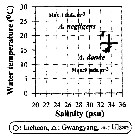 Issued from : J.-H. Kang in Ocean Sci. J., 2011, 46 (4). [p.228, Fig.5] Issued from : J.-H. Kang in Ocean Sci. J., 2011, 46 (4). [p.228, Fig.5]
Abundance-temperature-salinity diagram of A. danae observed in the seaports from Korea during 3 years (2007-2009). |
 Issued from : J.-H. Kang in Ocean Sci. J., 2011, 46 (4). [p.229, Fig.6] Issued from : J.-H. Kang in Ocean Sci. J., 2011, 46 (4). [p.229, Fig.6]
Abundance-total suspended solid-chlorophyll-a diagram of A. danae observed in the seaports from Korea during 3 years (2007-2009). |
 Issued from : J.-H. Kang in Ocean Sci. J., 2011, 46 (4). [p.230, Fig.7] Issued from : J.-H. Kang in Ocean Sci. J., 2011, 46 (4). [p.230, Fig.7]
Abundance-dissolved oxygen-chlorophyll-a diagram of A. danae observed in the seaports from Korea during 3 years (2007-2009). |
 Issued from : M. Madhupratap & P. Haridas in J. Plankton Res., 12 (2). [p.311, Fig.4]. Issued from : M. Madhupratap & P. Haridas in J. Plankton Res., 12 (2). [p.311, Fig.4].
Vertical distribution of calanoid copepod (mean +1 SE), abundance No/100 m3. 24- Acartia danae.
Night: shaded, day: unshaded.
Samples collected from 6 stations located off Cochin (India), SE Arabian Sea, November 1983, with a Multiple Closing Plankton Net (mesh aperture 300 µm), in vertical hauls at 4 depth intervalls (0-200, 200-400, 400-600, 600-1000 m). |
 Issued from : G.A. Lopez Ibarra in Tesis, Inst. Politec. Nac., CICIMAR, 2008. [p.37, Table 3]. Issued from : G.A. Lopez Ibarra in Tesis, Inst. Politec. Nac., CICIMAR, 2008. [p.37, Table 3].
Summary of abundance and stable isotopics 15N and 13C in Subeucalanus subcrassus.
O = main feeding: omnivore; T = tropical biogeographical affinity; zones (a-f) = Cf. fig.1 in the same author.
Compare with Subeucalanus subcrassus and other species (Tabla 3). |
| | | | Loc: | | | South Africa (E & W), off Tristan da Cunha NE, Namibia, Angola, Baia Farta, Congo, off S Ascension Is., off N St. Helena Is., G. of Guinea, off Lagos, Ivorian shelf, Dakar, Cape Verde Is., off Morocco-Mauritania, Cap Ghir, Canary Is., off Madeira, Azores, Brasil (Campos Basin, off Vitoria-Cabo de Sao Tomé, off Macaé, Amazon), Venezuela, Bahia de Mochima, Cariaco Basin, Caribean Colombia, Caribbean Sea, G. of Mexico, Florida, Sargasso Sea, off Bermuda: Station ‘’ S’’ (32°10’N, 64°30’W), Delaware Bay (outside), New York, off Woods Hole, off Nova Scotia, Ibero-moroccan Bay, Medit. (Alboran Sea, Sidi Fredj coast: near Algiers, N Tunisia, NW Basin, Baleares Is., Marseille, Ligurian Sea, Tyrrhenian Sea, Napoli, G. of Gabes, Adriatic Sea, Ionian Sea, S Aegean Sea, W Black Sea, Lebanon Basin, W Egyptian coast, Alexandria), Sharm El-Sheikh, Safaga, Red Sea, Arabian Sea, Arabian Gulf, Natal, off Madagascar S, Nosy Bé, Rodrigues Is. - Seychelles, Mascarene Basin, India (Mangalore coast, G. of Mannar, Porto Novo, Palk Bay, Lawson's Bay, Pointcalimere-Mallipattinam), E India, G. of Bengal, Burma, Indonesia-Malaysia, Cilacap Bay (S Java), Jakarta Bay-Seribu Islands, Lombok Sea, SW Celebes, Ambon Bay (Ceram Is.), W Australia, Pacif. (W equatorial), Australia (Great Barrier, New South Wales, off Sydney, North West Cape, G. of Carpentaria), New Caledonia, Tasman Sea, New Zealand (NE North Island), off Kermadec Is, Pacif. (N & S), Okinawa, Korea (S & SW), Japan Sea, Japan (Kuchinoerabu Is., Tokyo Bay, Izu, Onagawa, Toyama Bay, Tanabe Bay, Honshu: Suruga Bay), off SE Japan, China Seas (Hong Kong, South China Sea, East China Sea, Yellow Sea), Taiwan Strait, Taiwan (E, SW, N, NW), Korea Strait, Bering Sea, Aleutian Is., Canada Basin (rare), Alaska, British Columbia, Hecate Strait, Vancouver Is., off Washington coast, Oregon (off Newport), California, Santa Monica Basin, Sixtymile Bank, Baja California (Bahia Magdalena, W), G. of California, La Paz, W Mexico, G. de Tehuantepec, W Costa Rica, Fidji Is., Gilbert Is., Hawaii, Pacif. (equatorial, central N), Costa Rica, Galapagos-Ecuador, Peru, Chile (N) | | | | N: | 329 | | | | Lg.: | | | (16) F: 1,22-1,05; (34) F: 1,19-1,15; M: 0,9; (46) F: 1,16; (59) F: 1,3-1; M: 0,8-0,7; (72) F: 1,2; (101) F: 1,12; (104) F: 1,2; (119) F: 1,27-1,17; (164) F: 1,271-1,08; M: 0,806-0,732; (199) F: 1,22-1,06; (237) F: 1,25; M: 1,10; (237) F: 1,25; M: 1,10; (290) F: 1,15-1,25; M: 0,8-0,85; (432) F: 1,25-1,05; (786) F: 1,28-1,13; M: 0,86-0,82; (866) F: 1,1-1,3; M: 0,7-0,9; (909) F: 1,1-1,3; M: 0,8; (991) F: 1,05-1,27; M: 0,73-0,8; (1047) F: 0,9; (1110) F: 1,1-1,34; M: 0,72-0,86; (1122) F: 1,15; (1230) F: 1,1-1,3; M: 0,7-0,8; {F: 0,90-1,34; M: 0,70-1,10}
Chiba S. & al., 2015 (p.971, Table 1: Total length female (June-July) = 1.2 mm [optimal SST (°C) = 4.8]. | | | | Rem.: | Oceanic and littoral, epipelagic. Overall Depth Range in Sargasso Sea: 0-500 m (Deevey & Brooks, 1977, Station "S"). For Acha & al. (2020) this species is observed on shelfbreak in front of Rio de La Plata (Argentina).
Cosmopolitan: tropical and temperate (limited by latitudes 40° N & S, except in the extreme north Pacific cited only by Wilson, 1950).
After Björnberg (1963, p.63) in brazilian waters this species occurred in greater numbers in the samples from high salinity waters (above 35.00 p.1000) and lower temperatures (± 18°C), thus preferring subtropical conditions confirming Yamasi's (1958) classification of the species as temperate. It did not occur in samples of coastal waters. Heinrich (1961) found the species between 25° and 35° N in the west Pacific usually concentrated in the 25-50 m deep layer or in the 50-100 m layer, reaching down to 500 m. It is found in still deeper layers (580 to 1.040 m) near Japan (Furuhashi, 1961) in temperatures about 4 to 5°C.
According to Mulyadi (2004) this species is very rare around Indonesian waters.
For Itoh (1970 a, fig.2, from co-ordonates) the Itoh's index value from mandibular gnathobase = 740.
Timonin (1971, p.282) considers the trophic interrelations in the equatorial and tropical Indian Ocean, and divides the plankters into 6 trophic groups from the litterature and the results of studies of mouth-parts structure and intestine content. This species is omnivorous.
After Benedetti & al. (2018, p.1, Fig.2) this species belonging to the functional group 4 corresponding to small filter feeding herbivorous and mixed feeding omnivorous (mostly broadcasters).
See in DVP Conway & al., 2003 (version 1) | | | Last update : 25/10/2022 | |
|
|
 Any use of this site for a publication will be mentioned with the following reference : Any use of this site for a publication will be mentioned with the following reference :
Razouls C., Desreumaux N., Kouwenberg J. and de Bovée F., 2005-2024. - Biodiversity of Marine Planktonic Copepods (morphology, geographical distribution and biological data). Sorbonne University, CNRS. Available at http://copepodes.obs-banyuls.fr/en [Accessed April 17, 2024] © copyright 2005-2024 Sorbonne University, CNRS
|
|
 |
 |

























